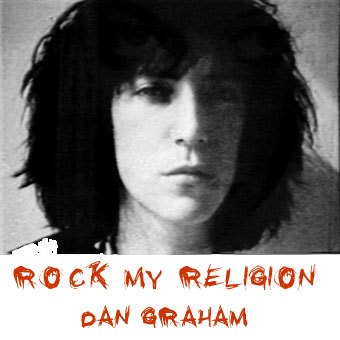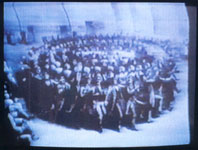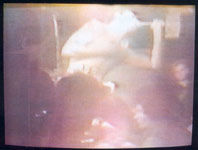
|
.
|
1982-84, 55:27 min, b&w and color, sound  Rock My Religion is a thesis on the relation between religion and rock music in contemporary culture. Graham formulates a history that begins with the Shakers, an early religious community who practiced self-denial and ecstatic trance dances. With the "reeling and rocking" of religious revivals as his point of departure, Graham analyzes the emergence of rock music as religion with the teenage consumer in the isolated suburban milieu of the 1950s, locating rock's sexual and ideological context in post-World War II America. The music and philosophies of Patti Smith, who made explicit the trope that rock is religion, are his focus. This complex collage of text, film footage and performance forms a compelling theoretical essay on the ideological codes and historical contexts that inform the cultural phenomenon of rock `n' roll music. Original Music: Glenn Branca, Sonic Youth. Sound: Ian Murray, Wharton Tiers. Narrators: Johanna Cypis, Dan Graham. Editors: Matt Danowski, Derek Graham, Ian Murray, Tony Oursler. Produced by Dan Graham and the Moderna Museet.   Dan Graham Biography Since the mid-1960s, Dan Graham has produced an body of art and theory that engages in analytical discourse on the historical, social and ideological functions of contemporary cultural systems. Architecture, popular music, video and television are among the focuses of his provocative investigations, which are articulated in essays, performances, installations, videotapes and architectural/sculptural designs. Graham began using film and video in the 1970s, creating installation and performance works that actively engage the viewer in a perceptual and psychological inquiry into public and private, audience and performer, objectivity and subjectivity. Restructuring space, time and spectatorship in a deconstruction of the phenomenology of viewing, his early installations often incorporate closed-circuit video systems within architectural spaces. The viewer's perception is manipulated and displaced through such devices as time delay, projections, surveillance and mirrors. In installations focusing on the social implications of television, as articulated in private and public viewing spaces, Graham refers to video's semiotic function in architecture in relation to both window and mirror. Graham has also published numerous critical and theoretical essays that investigate the cultural ideology of such contemporary social phenomena as punk music, suburbia and public architecture. Graham was born in 1942. He lives in New York. http://www.gvny.com/entertainment/arts/arts2-4.html A spiritual journey into the mosh pit.by Renata Bomtempo When I say the ‘80s, what do you first think about? Maybe, Molly Ringwald in the numerous films about adolescent love. Or does the song, " Lets get physical, physical…." ring a bell. Need I go on? Oh, one more thing, Flock of Seagulls haircuts everywhere! But when the ‘80s come to mind, religion does not come into that category. But Dan Graham decided to take the 1980s and incorporate religion, phallic symbols and women as minorities in the hard rock and punk scene. Dan Graham has been an important artist in the art scene of the ‘80s and one can see some of his works at the Whitney Museum on Madison Avenue. Dan Graham’s video titled, "Rock My Religion", was viewed last Saturday at the Whitney Museum with Robert Mapplethorpe’s " Still Moving" and Robert Franks’ "Summer Cannibals". " Rock My Religion" is an intriguing view into the world of punk bands and hard core bands that one might of never have thought of before. In his film he talks about two women Ann Lee, which was one of the pioneers of the Shakers, and Patty Smith a true rocker of the late ‘70s and ‘80s. He compares Ann Lee as a goddess and Patty Smith as Mary Magdalene, the prostitute that changed her ways when she encountered Jesus Christ and found Christ’s empty tomb after he was resurrected. Dan describes the Shakers related to punk and hard core music. The Shakers used to dance in a circle and scream out " Shake, Shake the devil". Dan describes this in a visual correlation to the mosh pits in punk and hard core concerts, where there is a circle in the middle of a crowd where people are dancing and "shaking the devil out". (Its hard to grasp at first, but stay with me.) There was a song that was sung in the film by Sonic Youth that included lyrics that rang out "Shake, Shake, Shake!" Then the camera shifts away from the band and to the crowd where they are rampaging around in a circle and shoving away. But why is Ann Lee a goddess to Dan Graham is a fascinating question. I do not think that I quite capture the relationship in the term goddess to Ann Lee towards rock music. The definition of a god is a being that is supernatural, omniscient ruler of the universe and worshiped by a people. With this in mind one might see Ann Lee as the creator of the "Shakers" and worshiped by rocking teenagers dancing to the music of punk music, while they are reliving the traditions of the Shakers. But, I am sure that most of these teens do not even know who the Shakers are. But, it is fascinating to see that the teenagers are involved in much the same manner as the Shakers did when they massed together and chanted against the devil. In much the same way, one can see this in the mosh pit. Dan also uses Patty Smith in his film as a Mary Magdalene. Patty Smith’s Jesus Christ was her guitar. She has said that the guitar felt so right on her hands and she knew what she wanted to be when she first played the guitar and she found her path through the guitar. Dan also presented the fact that rock can be very phallic, the microphone, the stereotypic image of male rockers and Dan also incorporated the moves of Elvis. Patty Smith has said that she wanted to be a man, because she wanted to be a rocker and women were not rockers in the sense of punk and hard core music until Patty Smith came into the scene. She is the Courtney Love of the ‘80s. Smith wanted to be thought of as a rocker, but the idealized image of a woman was evident in the late ‘70s and singing and sweating out on stage wasn’t one of them. Dan used the art form of the video and media to enhance the politics of music. The film was conceived with clips of the shakers and the ‘80s rock scene and intertwined with narrators and music that hold a theme of religion that was never looked at when it came to music, which appears on the surface , so polar to religion. The next film was from Mapplethrope’s "Still Moving". This black and white film was shot in 1978 and it is Patty Smith amidst curtain hung over a wall and sitting among bundles of cloth. She is under the influence of MDA and she is moving around that corner of cloth. The film is a correlation of photographs that are being taken at the same time as the film is being shot. Thus, the final project is a combination of photos and film. It appears as a documentary of personal experience and discovery and it is best to see it first without knowing that she is under the influence of a drug. One sees her going through experiences of fear and touch, a video looking class into the eyes of Patty Smith. It was a perfect idea to show the two films together so as to get an inside look at different aspects of rock and women. Patty Smith’s performance piece, "Still Moving" was a provocative approach to the senses and an emotional journey into her art world. "Rock My Religion" is part of "The American Century: 1900-2000" an exhibition at the Whitney where one can see the likes of Jackson Pollack, Jeff Koons and of course Any Warhol. If you have not gone to see that show yet, it is closing on February 13, 2000. I definitely urge that every student, and I do not just mean art history students, go see this exhibition. It contains such potent portraitures of the American way of life and the military influence of middle class Americans. The clarity that Dan Graham’s " Rock My Religion" brings to this exhibition is a formulation of pop art and awareness that the ‘80s were not just Debbie Gibsons or walkmans, but the involvement of spiritual celebration. One that sometimes is not seen at first glance, but I do not think that I can ever look at punk and hard core music again without thinking about a religious ceremony of shaking out the devil. |